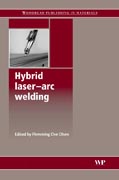
Hybrid laser-arc welding (HLAW) is a combination of laser welding with arc welding that overcomes many of the shortfalls of both processes. This important book gives a comprehensive account of hybrid laser-arc welding technology and applications. The first part of the book reviews the characteristics of the process, including the properties of joints produced by hybrid laser-arc welding and ways of assessing weld quality. Part 2 discusses applications of the process to such metals as magnesium alloys, aluminium and steel as well as the use of hybrid laser-arc welding in such sectors as ship building and the automotive industry. With its distinguished editor and international team of contributors, Hybrid laser-arc welding, is a valuable source of reference for all those using this important welding technology. INDICE: PART 1 CHARACTERISTICS OF HYBRID LASER-ARC WELDING Advantages and disadvantages of arc and laser welding E Reutzel, Pennsylvania State University, USA Introduction. Arc welding. Laser welding. Acknowledgements. References.Fundamentals of hybrid laser-arc welding S Katayama, Osaka University, Japan Introduction. Plasma characteristics including interaction between laser beam and arc. Dynamic behaviour. Melt dynamics and melt pool stability. Formation and prevention mechanism of porosity. References. Heat sources of hybrid laser-arc welding processes A Mahrle and E Beyer, Dresden University of Technology, Germany Introduction. Laser beam heat sources. Arc heat sources. Combinations of laser beams and arcs. Future trends. References. Effect of shielding gas onhybrid laser-arc welding M Gao and X Zeng, Huazhong University of Science andTechnology, China Introduction. Common types and physical properties of shielding gases. Effects of shielding gas in hybrid welding. Effects of shielding gas on the mechanical properties of hybrid weld. Conclusions and sources of further information and advice. References. Properties of joints produced by hybrid laser-arc welding V Kujanp„a, Lappeenranta University of Technology, Finland Introduction. Microstructure of hybrid laser-arc welds. Hardness. Strength. Toughness. Fatigue properties. Corrosion properties. References. Quality control and assessing weld quality in hybrid laser-arc welding J K Kristensen, FORCE Technology, Denmark Introduction. Weldability of typical structural materials. Weld quality. Assessment of weld properties. Conclusions. Acknowledgments. References. PART 2 APPLICATIONS OF HYBRID LASER-ARC WELDING Hybrid welding of magnesium alloys L Liu, Dalian University of Technology, China Introduction. Weldability of magnesium alloys. Low-power laser-arc hybrid welding process. Numerical simulation. Infrared temperature measurement. Spectral diagnose. Interaction between laser beam and arc plasma. Practical application. Conclusions and future trends. References. Shipbuilding applications of hybrid laser-arc welding J K Kristensen, FORCE Technology, Denmark Introduction. The approval of laser based welding in shipbuilding. Industrial examples. Conclusions. References. Industrial robotic application of laser-GMAW and laser-Tandem hybrid welding H Staufer, Fronius International GmbH, Austria Introduction. Laser hybrid process for industrial applications. Applications and case studies in the automotive industry. Application in shipbuilding. Synergies by LaserHybrid. The Laser-(GMAW-Tandem) Hybrid welding process in the automotive industry. Application of laser-tandem welding in the pipeline industry. Laser-tandem hybrid welding system. Laser hybrid welding with three arcs: principle of the Laser-GMAW and laser-tandem welding. Conclusions. References. Hybrid laser-arc welding of aluminium C Thomy, BIAS - Bremer Institut für angewandte Strahltechnik GmbH, Germany Introduction. Aluminium and its alloys. Fusion welding of aluminium alloys. Hybrid laser-arc welding processes for aluminium alloys. Properties of hybrid laser-arc welds. Applications. Future trends. References. Hybrid laser-arc welding of dissimilar metals C Thomy, BIAS - Bremer Institut für angewandte Strahltechnik GmbH, Germany Introduction. Specific aspects of and state-of-the-art in joining of dissimilar metals. Basic features of laser MIG hybrid welding for dissimilar metals. Process and joint properties. Application potentials. Future trends. References. PART 3 HYBRID LASER-ARC WELDING OF STEEL Hybrid laser-arc welding of steel S Katayama, Osaka University, Japan Introduction. Hybrid laser-arc welding of steel and high tensile strength steel. Hybrid laser-arc welding of Zn-coated steel. Hybrid laser-arc welding of stainless steel. References.
- ISBN: 978-1-84569-370-1
- Editorial: Woodhead
- Encuadernacion: Cartoné
- Páginas: 336
- Fecha Publicación: 01/06/2009
- Nº Volúmenes: 1
- Idioma: Inglés
